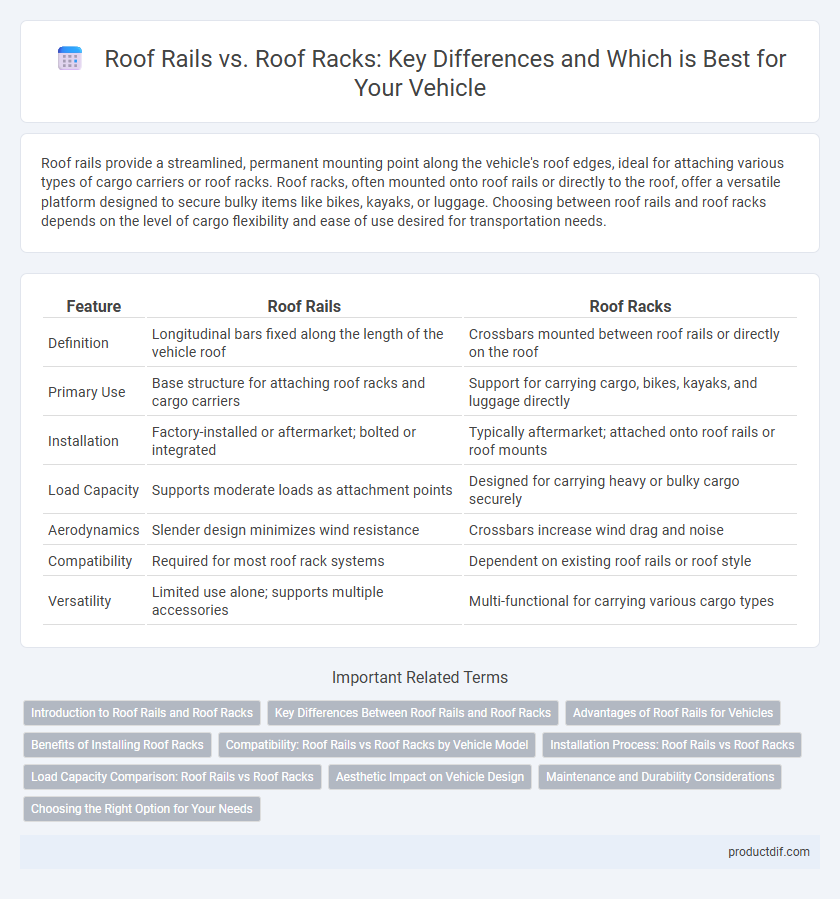Roof rails provide a streamlined, permanent mounting point along the vehicle's roof edges, ideal for attaching various types of cargo carriers or roof racks. Roof racks, often mounted onto roof rails or directly to the roof, offer a versatile platform designed to secure bulky items like bikes, kayaks, or luggage. Choosing between roof rails and roof racks depends on the level of cargo flexibility and ease of use desired for transportation needs.
Table of Comparison
| Feature | Roof Rails | Roof Racks |
|---|---|---|
| Definition | Longitudinal bars fixed along the length of the vehicle roof | Crossbars mounted between roof rails or directly on the roof |
| Primary Use | Base structure for attaching roof racks and cargo carriers | Support for carrying cargo, bikes, kayaks, and luggage directly |
| Installation | Factory-installed or aftermarket; bolted or integrated | Typically aftermarket; attached onto roof rails or roof mounts |
| Load Capacity | Supports moderate loads as attachment points | Designed for carrying heavy or bulky cargo securely |
| Aerodynamics | Slender design minimizes wind resistance | Crossbars increase wind drag and noise |
| Compatibility | Required for most roof rack systems | Dependent on existing roof rails or roof style |
| Versatility | Limited use alone; supports multiple accessories | Multi-functional for carrying various cargo types |
Introduction to Roof Rails and Roof Racks
Roof rails are factory-installed, aerodynamic bars running parallel along a vehicle's roof designed to support roof racks and cargo. Roof racks are detachable systems mounted onto roof rails or directly on the roof, providing a platform to carry bikes, luggage, or other bulky items. Understanding the distinction between roof rails and roof racks is essential for optimizing vehicle cargo capacity and ensuring safe transportation.
Key Differences Between Roof Rails and Roof Racks
Roof rails are fixed, longitudinal bars mounted directly to a vehicle's roof designed to serve as a base for attaching roof racks or other accessories, whereas roof racks are complete systems including crossbars that enable secure transportation of cargo such as bikes, kayaks, or luggage. Roof rails typically run parallel to the vehicle's length and often come pre-installed by manufacturers, offering flexibility for aftermarket rack installation. Roof racks provide the structure and support needed to carry various gear, with crossbars positioned perpendicular to roof rails or directly mounted to the roof, enhancing load stability and versatility.
Advantages of Roof Rails for Vehicles
Roof rails offer enhanced versatility by allowing easy attachment of various carriers and accessories without permanent modifications to the vehicle. They improve vehicle aerodynamics compared to traditional roof racks, resulting in better fuel efficiency and reduced wind noise. Roof rails also contribute to a sleeker, integrated appearance while providing robust support for carrying luggage, bikes, or kayaks securely on SUVs and crossovers.
Benefits of Installing Roof Racks
Installing roof racks enhances vehicle versatility by providing a secure platform for transporting bulky items such as bicycles, kayaks, and luggage, freeing up interior space. Roof racks improve cargo capacity and promote better weight distribution, which can improve vehicle stability during travel. Their robust design allows for easy customization with accessories, catering to diverse outdoor and travel needs.
Compatibility: Roof Rails vs Roof Racks by Vehicle Model
Roof rails are long bars running parallel to the vehicle's length, designed as a base for mounting roof racks, which carry cargo. Compatibility depends on the vehicle model; many crossovers and SUVs come equipped with factory-installed roof rails compatible with specific roof rack systems tailored to those rails. Sedans and hatchbacks often lack roof rails, requiring clamp-on roof racks that fit the door frame for secure cargo transport.
Installation Process: Roof Rails vs Roof Racks
Roof rails are typically factory-installed or require professional mounting, attaching directly to the vehicle's roof and serving as a base for accessories. Roof racks, on the other hand, often involve a more adaptable installation process, clamping onto the roof rails or crossbars for specific cargo needs. Understanding the compatibility between roof rails and roof racks is essential for secure and efficient mounting.
Load Capacity Comparison: Roof Rails vs Roof Racks
Roof racks typically offer a higher load capacity compared to roof rails, supporting weights up to 165 pounds or more, while roof rails generally handle around 75 to 100 pounds. This difference is crucial for transporting heavy items like kayaks, storage boxes, and bicycles safely. Choosing the appropriate system depends on the vehicle's roof strength and the intended cargo load requirements.
Aesthetic Impact on Vehicle Design
Roof rails subtly enhance a vehicle's silhouette, maintaining a sleek and integrated look that complements the overall design without overpowering the aesthetics. Roof racks, often bulkier and more utilitarian, create a rugged, function-first appearance that can disrupt the vehicle's streamlined profile. Choosing between roof rails and roof racks involves balancing style preferences with intended use, where roof rails offer a refined aesthetic impact while roof racks prioritize practicality.
Maintenance and Durability Considerations
Roof rails require less maintenance due to their integrated design, reducing exposure to elements and minimizing corrosion risk. Roof racks, often detachable, demand regular checks for secure fittings and protection against rust, especially in harsh weather conditions. Durability of both depends on material quality, with aluminum and stainless steel offering superior resistance to wear and environmental damage.
Choosing the Right Option for Your Needs
Roof rails provide a streamlined base fixed along the edges of a vehicle's roof, ideal for mounting various accessories, while roof racks are detachable frameworks that attach to these rails or directly to the roof, designed to carry heavier or bulkier items. When choosing between roof rails and roof racks, consider your specific transport needs, such as the frequency of use, load capacity, and the type of cargo like bikes, kayaks, or luggage. Opt for roof racks if you require versatility and heavy-duty support, whereas roof rails offer a more permanent, aerodynamic solution for casual or light cargo transport.
Roof Rails vs Roof Racks Infographic

 productdif.com
productdif.com